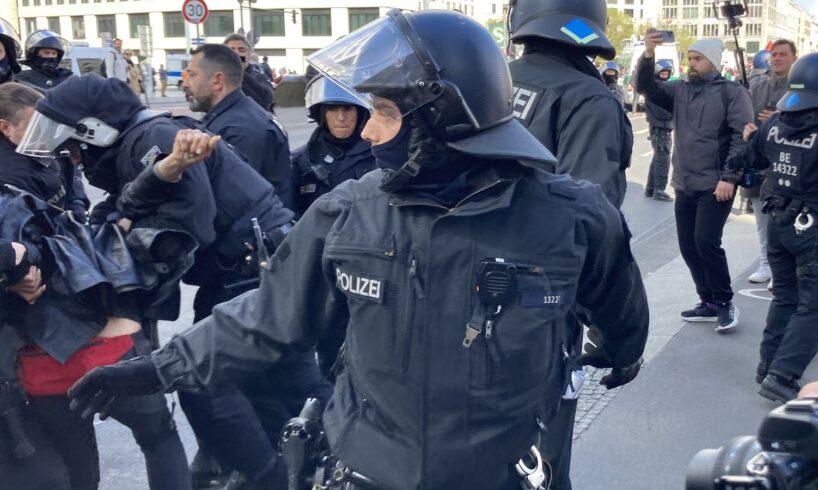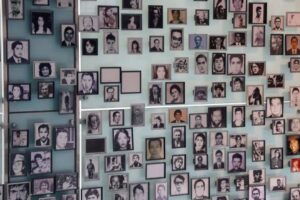
The General Security and Order Act (ASOG) “reform” by the Berlin state government, a coalition of the Christian Democratic Union (CDU) and Social Democratic Party (SPD), is part of a frontal assault on fundamental democratic rights.
Police take action against peaceful demonstrators at the pro-Palestine demonstration on Potsdamer Platz in Berlin, April 20, 2024
The ruling coalition in Berlin is presenting this assault as a necessary modernisation of the police in the name of public safety. “The dangers are growing,” claimed Burkard Dregger, the CDU’s domestic policy spokesman, “coming from within the country as well as from abroad.” Therefore, said Interior Senator (state minister) Iris Spranger (SPD), Berlin was “relying on technological modernisation because the police must not be weaker than the criminals.”
In reality, the new police and public order law is not designed to protect the population, but to enable its comprehensive surveillance and repression. It represents a step toward a police state.
The ASOG amendment, which runs to over 700 pages, was presented to the House of Representatives (state assembly) by the relevant interior department in mid-July this year. On 18 December, the members of parliament are to vote on the final version, which is scheduled to come into force in January 2026.
Regardless of the exact wording of the final version, the new police and public order law represents an expansion of state powers directed against the working class: every person may be video-monitored at any time and in any public place, and mobile phone communications may be intercepted. Images from video surveillance can be compared with and stored alongside photographs available online.
Expansion of video surveillance in public spaces
The seven current locations classified by the police as “crime-prone areas” (kbO)—including Alexanderplatz in Mitte and Kottbusser Tor and Görlitzer Park in Friedrichshain-Kreuzberg—are to be subject to permanent police surveillance. Previously, this was only allowed temporarily.
Regardless of the actual frequency of crimes such as robbery, serious bodily harm, arson or drug trafficking, the police can make such a classification based on their own operational presence, for example during “assemblies known from experience to be prone to conflict.”
For residents of Hermannstrasse and Hermannplatz in Neukölln—districts with a high Arab and Palestinian population—the kbO classification, which grants the police special and largely arbitrary powers, became dramatically apparent at the turn of the year from 2023 to 2024.
Following the announcement of pro-Palestinian demonstrations, the police blocked Hermannplatz, Sonnenallee and Reuterplatz with dozens of vehicles. Mass identity checks and bag searches of residents and passers-by were carried out across the area, and police violence and brutality were widespread.
Deploying AI analysis
For the first time, artificial intelligence (AI) is to be used to analyse video data to supposedly identify “conspicuous behaviour patterns.” These include pacing back and forth in front of an object, prolonged observation, running or moving hastily in unusual areas, “suspicious” gatherings, or sitting or lying down for longer periods in unusual locations.
As already practised in Mannheim (since 2018), Hamburg (since 2023) and Frankfurt (since the summer of 2025), the AI programme will be fed with all available image material: from surveillance cameras, public events or gatherings, footage of vulnerable buildings and objects, to images from helicopters and drones.
Data-protection experts warn that in future “large parts of central Berlin will no longer be able to be passed through unobserved” [Meike Kamp, data-protection officer of the Berlin House of Representatives] and “people who behave atypically in a public space—such as the homeless or physically impaired—will be identified by the software as dangerous and thus exposed to increased surveillance pressure” [David Werdermann, lawyer with the Society for Civil Rights].
The storage period for video recordings from transit operator BVG’s cameras monitoring train stations and stops will be extended from 48 to 72 hours, representing another step toward comprehensive data collection and data retention.
The CDU-SPD state government insists that “biometric real-time identification” (facial recognition) is excluded from the bill and that AI will be used only to detect patterns of movement or group behaviour. However, in cases of targeted searches for specific individuals, judicial approval would allow AI use.
It is obvious that AI will ultimately be used to restrict and monitor opposition groups and individuals, hindering their right to assemble and labeling them as “threats.”
“Deadly force”
For the first time, police officers in Berlin will have the legal right to use “deadly force,” i.e., to deliberately kill. Yet the police are already potentially deadly with their firearms, tasers and painful holds.
Nationwide, at least 44 people died in police operations last year, 22 of them from gunfire. Most deaths occurred in North Rhine-Westphalia (7), Berlin and Bavaria (5 each), and Hesse (3). The majority of those killed suffered from mental health conditions. The real number is likely higher, as official data are incomplete or lacking altogether.
In addition, the use of real-time AI image analysis will “upgrade” police operations. Whereas firearms were previously restricted to immediate, observable threats (including subjective misjudgements), algorithmic analysis may now prompt officers to use force, including firearms. Traditional “eyewitness assessment” is thus supplanted—or overridden—by a supposedly objective algorithm.
State trojans, telecommunications monitoring and online searches
The bill also massively expands digital surveillance.
With judicial approval, the police will gain access to all end-to-end communications and emails. With court authorisation, the authorities may deploy “state trojans,” snooping software, to extract or monitor all communication data, stored files, running applications and non-public social-media content from IT systems in real time.
All regular and incidental communication partners of the target person—the so-called “bystander-catch”—will also fall within the surveillance radius. What only a few years ago seemed like a dystopian science-fiction scenario is now declared an official tool for “prevention.”
At the same time, a pending reform of Berlin’s constitutional protection law (VSG Bln) will expand intelligence access to all surveillance videos and online communications, further strengthening cooperation between police and intelligence agencies.
The amendment of the so-called “constitutional-protection law” is directly linked to the ASOG reform. The CDU and SPD praise both as a single “security package.” Police and intelligence powers complement one another institutionally and substantively.
This amounts to the abolition of the separation between police and intelligence services, a principle enshrined in law after the experience of Nazi dictatorship and the Gestapo.
Suppression of the population
The build-up of police state structures serves only one purpose: the state government is preparing for class war against the working class.
While Berlin’s public schools are deteriorating, social services are being shut down, and brutal cuts are taking place at hospitals, universities and public infrastructure, the coalition ruling Berlin is pouring millions into expanding the machinery of repression.
This development is not limited to Berlin or Germany, but is part of a worldwide authoritarian shift to the right. Everywhere, governments respond to growing social inequality, mass protests against poverty, soaring rents, the genocide in Gaza, militarisation and war with intensified surveillance, intimidation and criminalisation.
The rising number of demonstrations reflects this opposition: in Berlin alone, there were 7,151 protests in 2023 and 7,665 in 2024—over 20 a day. Resistance is growing, and the state government is preparing to crush it.
The CDU-SPD coalition can count on the support of the Greens and the Left Party. The Left Party was one of the parties introducing the original ASOG during the SPD-Left Party coalition controlling the Berlin state executive in 2007. It suppressed internal critics of the expanded video surveillance powers. As recently as 2017, in coalition with the SPD and Greens, it backed a massive increase in the Berlin police budget and demanded more police presence “in the name of security.”
Despite its current criticisms of the ASOG reform, the Left Party supports and participates in building the state’s repressive apparatus against the working class.
Against the escalation of state repression and surveillance, the Sozialistische Gleichheitspartei (Socialist Equality Party) calls on all workers, students and opponents of war to unite in an independent and conscious political struggle. Governments are resorting ever more openly to authoritarian and fascistic methods to defend their war policies and the immense wealth of corporations and elites against mounting opposition.
Only a united, international struggle of the working class for socialism can halt this drive toward dictatorship and war.
Sign up for the WSWS email newsletter





